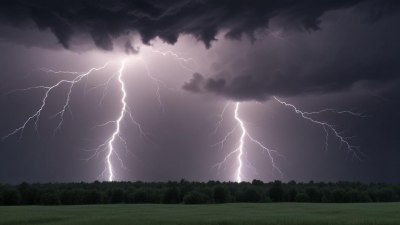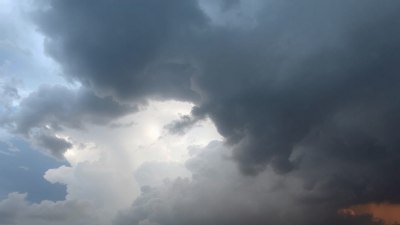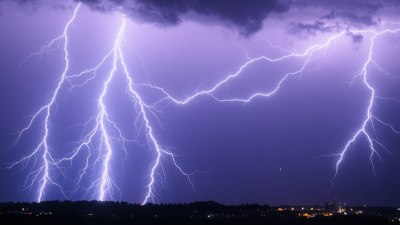Why Are Some Thunderstorms Silent
Explore the intriguing phenomenon of silent thunderstorms and understand their causes in this informative article.

This image was created with the assistance of Freepik
Thunderstorms are often associated with loud claps of thunder, dramatic lightning, and heavy rainfall. However, there are instances when thunderstorms produce little to no sound, leading to a phenomenon known as silent thunderstorms. Understanding why some thunderstorms display this unusual characteristic can offer insights into meteorology, sound propagation, and atmospheric conditions. In this article, we will delve into the factors that contribute to silent thunderstorms, the science behind thunder production, and its implications on weather forecasting and safety.
What Causes Thunder?
To grasp why some thunderstorms are silent, it's essential to first understand the mechanics of thunder itself. Thunder is produced by the rapid expansion and contraction of air surrounding a lightning bolt. When lightning strikes, it creates a high-temperature channel that rapidly heats the air to around 30,000 degrees Fahrenheit. This intense heat causes the surrounding air to expand explosively, leading to the thunder sound we hear. The resulting shockwave travels through the atmosphere, where different conditions can affect its audibility.
The Role of Precipitation
Precipitation type and intensity can significantly influence the ability to hear thunder. In thunderstorms characterized by heavy rain or hail, the sound of falling raindrops or hailstones can obscure the sound of thunder. This effect is particularly evident in tropical thunderstorms, where rain intensity is high, and sounds are often muffled. When thunder occurs at a distance, it may be drowned out by the sound of pouring rain, creating an impression of a silent storm.
Distance from the Observer
The distance between the observer and the thunderstorm can also play a crucial role in the thunder's audibility. As sound waves travel, they dissipate energy and weaken, making it more challenging to hear thunder over long distances. For instance, if a storm is more than a few miles away, the sound of thunder may not reach the observer or may be too faint to be recognized. In contrast, storms that are closer will produce louder, more pronounced thunder that can often be heard from significant distances.
Atmospheric Conditions
The atmospheric conditions at the time of a thunderstorm can create a setting where thunder is less likely to be heard. Temperature inversions, for example, occur when a layer of warm air traps cooler air beneath it. This phenomenon can cause sound waves to bend back towards the ground, leading to reduced sound propagation. Consequently, thunder may be produced, but because the sound waves are refracted upward, they may never reach the observer on the ground.
Wind Effects
Wind can have a significant impact on how sound travels. Under certain conditions, particularly when strong winds are present, the sound of thunder can be carried away from the observer. The wind may funnel the sound waves in a particular direction, effectively dispersing the thunder, making it less audible to those positioned outside the storm's path. In essence, observers situated upwind of a thunderstorm may experience muted or completely silent conditions even during intense storm activity.
Types of Silent Thunderstorms
There are various types of thunderstorms that can exhibit silence or reduced thunder activity. Heat thunderstorms, also known as pulse storms, are typically characterized by a single, towering cumulonimbus cloud that produces short-lived rainfall and occasionally silent thunder. These storms may not generate the classic booming sounds associated with thunderstorms and are often ephemeral by nature.
Changes in Thunder Frequency
Some thunderstorms produce thunder with varying frequency and intensity. For example, a storm might start with loud claps of thunder and then transition to periods of silence. This variability can occur due to changes in the storm's intensity, the activity level of lightning, or alterations in atmospheric conditions that affect sound propagation. Observers may find themselves hearing thunder intermittently in such situations, contributing to an overall impression of a silent thunderstorm.
Methods of Measurement
Scientists use various instruments to measure thunder's intensity, frequency, and audibility. Acoustic measurements involve deploying microphones to capture sound waves generated by thunder. These studies help researchers understand better how different atmospheric conditions influence thunder's characteristics and why some storms may appear silent. Findings from these measurements contribute valuable data for predicting thunderstorm behavior and enhancing weather forecasting models.
Implications for Safety
The tendency for a storm to be silent can have practical implications for public safety during severe weather events. Observers may underestimate the danger presented by silent thunderstorms, leading them to dismiss cautionary measures. Individuals should always be aware that thunder may not always accompany lightning, and the absence of audible thunder does not indicate the absence of severe weather conditions. It is imperative to remain vigilant, prioritize safety, and heed warnings from official meteorological sources even during silent storms.
Silent thunderstorms represent a fascinating aspect of meteorology, revealing the complex interplay of atmospheric dynamics, sound propagation, and environmental factors. While thunder is an expected feature of thunderstorms, the conditions that lead to silence can stem from precipitation, distance, atmospheric stratifications, and wind patterns. By understanding the science behind silence in thunderstorms, we gain a deeper appreciation for weather phenomena and the importance of safety awareness during such events. Whether with thunder or without, every thunderstorm warrants respect and caution from those in its vicinity.











